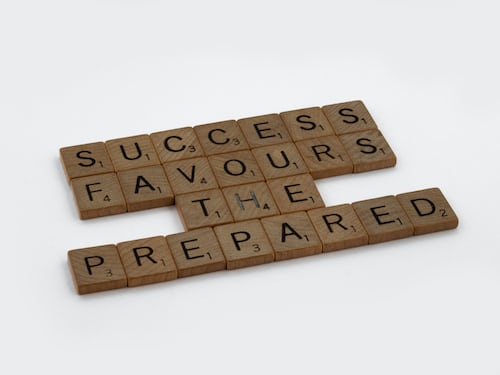How to evolve from remote selling to virtual selling
The changes the world has seen in the past few years have exponentially altered the way we work and conduct business. For many people, the COVID pandemic presented significant challenges to many aspects of life, but, in some ways, it almost catapulted us forward when it comes to innovation. It could be said that a positive aspect that came out of lockdowns, curfews and endless PCR tests is that we were almost teleported about 5 years into the future technologically.

The complete scope of what is considered to be normal work practices has changed. Before COVID, the percentage of businesses with remote workers was three times less compared to now. Most people have had some form of experience in remote or hybrid working, which has led to a significant shift in how clients, customers and consumers respond to business.

Shortcuts:
- What’s the Difference Between Remote Selling and Virtual Selling?
- How Has Remote Selling Transitioned to Virtual Selling?
- Does Virtual Selling Work?
- Key Virtual Selling Statistics
- How Can You Be Effective at Virtual Selling?
- Is Virtual Selling Going to Stay?
For many people, it’s now completely normal to purchase things online or have an entire customer experience without ever seeing a face or having an actual conversation. This also means that the nature of selling is dramatically different from what it has been in the past.
The migration to more online spaces has produced some beneficial practices to help salespeople build better portfolios and get a competitive edge in the market, but how can you get the most out of this?
The answer could lie in evolving from remote selling to virtual selling, but what is the difference between the two? How can you improve your virtual selling practices? All of this and more is below.
What’s the Difference Between Remote Selling and Virtual Selling?

For many, it might seem that remote selling and virtual selling are the same thing, but there is actually a slight difference between the actual meaning of the terms. They do refer to similar things, so it’s understandable that they are sometimes used in an interchangeable fashion.
Remote selling basically refers to the ability to sell products or services without the customer needing to visit a brick-and-mortar location. This can encompass anything from a company having elements of their business available online to having a completely remote selling model.
When the term virtual selling is used, it’s talking about leveraging technology and online resources to amplify the reach and efficacy of sales.
Remote selling and virtual selling are, indeed, referring to similar aspects of sales, but it’s possible to remote sell without ever truly capitalising on virtual sales.
Think of it like this. Remote selling is making it possible for your customers to purchase online, and virtual selling is about implementing the best possible practices and resources to get the most out of online sales.
How Has Remote Selling Transitioned to Virtual Selling?

Remote selling isn’t really a new concept; it’s technically been around for a long time. Mail-order systems are a great example of early remote selling.
Since the advent of digital innovation amplified what is possible with remote sales, it has become more normalized than ever, which also means that simply having a remote option available isn’t really enough to get a better competitive footing.
Consumers now have preferences in how they deal with remote sales, and the social and psychological aspects of how they interact with online spaces and platforms greatly impact this. The end result of the ‘new normal’ is that in order to reach more potential customers and convert more leads, it’s necessary to take a more holistic approach to the digital customer journey.
To be as effective as possible, successful businesses have naturally transitioned from simple remote selling to better evaluate and evolve their digital practices into virtual selling.
Does Virtual Selling Work?

The simple answer is yes. Most sales experts agree that virtual selling yields at least the same but often better results than the traditional sales models in the past that required some level of face-to-face contact.
The general consensus within the sales community is that virtual selling puts an emphasis on the ability to cater to individual customers’ needs by using technologies that ensure salespeople work smarter.
Key Virtual Selling Statistics

One of the best things about virtual selling is that most processes that involve technology also collect data which can give us some very powerful metrics to quantify success. There are endless data sets available that show the positive effects of virtual selling on businesses.
Since 2015 there has been a 60% increase in the amount of time sales representatives spend with customers in a virtual environment, and this figure doesn’t look like it’s going to decrease any time soon.
Customers have also changed a lot in how they do business. More than 65% of the job market in North America work remotely for more than half of their work week. This means that for many people, the only way to actually reach them is virtually.
It’s also not just in the methods that people work, buy and sell; it’s also reflected in preferences. A recent annual report on sales conducted by LinkedIn revealed that more than 70% of customers and 91% of salespeople actually prefer to operate remotely.
The stats definitely show that virtual selling is the way to go, but there are some other numbers to take into account. Although it works well, there’s a lot of room for improvement for businesses that utilise virtual selling.
A recent study showed that only 26% of virtual consumers feel that the salespeople they deal with are actually skilled at virtual selling, and 74% feel that virtual sellers aren’t very competent listeners. So we can see that although virtual selling works, for many salespeople, it could actually work a whole lot better.
How Can You Be Effective at Virtual Selling?

There are some simple actions and processes that can be put into place that can really level things up for virtual sellers. They cover a wide range of elements in the customer journey, and implementing some or all of them can lead to greater conversion rates.
Prepare For All Meetings

It’s imperative to make sure you are prepared for all sales-related meetings. Initiating contact with a prospect via the phone or even through video call might seem a little bit more casual, but it doesn’t mean that preparation should be casual too.
Before any calls are made, a salesperson should take the time to get some form of research on the lead. What are their demographics and psychographics? What are the values of the lead? Where did they come from, and what are they looking for?
Arming yourself with as much information as possible will enable you to adjust your presentation and sales pitch to meet their specific needs and eventually convert them into regular customers.
Preparation is always key in face-to-face sales, and it is no different in a virtual selling environment.
Use Video Messages

Video is an incredibly powerful tool in sales, and that’s mainly because humans are naturally attracted to visuals. According to MIT, 90% of the information processed in the human brain is visual. For this reason, utilizing video content to assist virtual selling is a no-brainer (pun intended).
Videos can be used to illustrate points, answer FAQs or even to communicate entire sets of information. Another great asset of video is that it can help to ensure that leads have all the information they need to make an informed decision.
Video is also an often underutilized resource in sales, so it’s a great way to set yourself apart from the competition. It has also never been easier or cheaper to make video content. It’s easy to record your screen and webcam and then embed the video into your emails.
Train to Be Able to Facilitate Virtual Meetings

Virtual selling isn’t just a case of sending a link to a screen-sharing session when you have qualified a lead on a sales call. Nothing can kill an online sales pitch quicker than not really knowing how to use the platform you have chosen or executing the meeting in a subpar way.
Take the time to look at your sales process and customer journey and figure out how all of this works in an online space. If there are visuals you would like to show, how are you going to show them? Put yourself in the shoes of the potential lead and think about how to make the process as seamless for them as possible.
In video conferencing, lighting, sound, and your physical appearance are all determining factors in success. Think about the angle that the camera is positioned, the available light in the room and if there are any items in the frame that may distract the customer. Yes, it’s now possible to just roll out of bed and start working, but a good salesperson doesn’t look like that’s the case.
Develop Questioning Skills

Good question skills have always been essential in the initial stages of a sale. This doesn’t change in a virtual selling environment. Questioning skills are an important early-stage sales funnel process, and it may be necessary to revise the typical questions you ask when dealing with leads virtually.
Apply Active Listening

Great salespeople are also good active listeners, and this is perhaps even more important in virtual sales. Active listening isn’t just hearing what a person is saying; it’s the ability to decipher chosen words and nuances to determine a higher level of understanding.
Not every lead is going to be great at expressing what it is that they are looking for, so the ears of the salesperson need to be open and attentive. Generally, active listening is where a person listens without judgment or interruption.
It’s very important to remember that although you might not be physically in front of a person, they need to feel that they have your undivided attention. Maintaining direct contact with the lens of a video camera is very important in a virtual meeting. Avoid becoming distracted by additional processes. The prospect should feel like they are the only person who exists and that you are aiming to understand everything they are saying.
Create Engaging Presentations

In many ways, a basic Slides or Keynote presentation isn’t really enough anymore, especially when it comes to virtual selling. When you think about it, most professionals are bombarded with presentations in their everyday lives, so their keen eyes are more critical than ever before.
Make sure that any slides or visual aids enhance the sales pitch and aren’t just gimmicks. As a rule of thumb, a good pitch presentation should have no more than 10 slides, last no longer than 20 minutes, and the font on the slides should be no smaller than 30 points.
Work on Relationship Building

Building strong relationships with prospects helps them to develop trust in you, which, in turn, tends to make them more comfortable when forming purchasing decisions. Relationship building can start very early in the sales process through simple things like sending meeting reminders and summaries.
Once a relationship is established, it can be a good idea to keep ‘small talk’ information on hand from previous conversations. If a lead mentioned they just started a new job in your first meeting, and you ask how it is going in the second, they will not only be impressed that you remembered this small piece of information, you will have effectively made the interaction more personal which is one of the easiest ways to foster good customer relations.
The basic principle of good relationship building in virtual sales is to aim to make sure the customer feels like a person with individual needs rather than a source of income for your business.
Deliver Virtual Document Sharing

Showing a prospect how competent you are in the virtual space can be enhanced with the use of virtual documents and the ability to share them. Most people have experienced screen sharing in some capacity, so incorporating it into sales meetings can further cement the trust a lead has in you. Making the sharing of documents as seamless as possible will set you apart from the competition.
With the innovations offered by platforms like CrankWheel, it’s even possible to present without the customer needing to download and install the software. They can access a presentation from anywhere in the world as simply as clicking a link in an email or text message. You can even share screen in a WhatsApp chat.
Be Able to Gather eSignatures

There are many ways to gather and store eSignatures now, which can revolutionize your digital business and decrease the time it takes to officially declare a lead as converted. There are very few cases where it’s absolutely necessary to deal with physical paperwork anymore. Full digitization isn’t just more time efficient; it also helps to reduce your company’s carbon footprint.
Create a Conversational Environment, not a Sales Pitch

Being an effective virtual seller is more than just sitting behind a computer and making all the right noises as a customer talks. The entire process is an interaction between two people, and both parties need to feel that way.
It can be very beneficial to take the time to get to know a client in an online space. Ask them questions about their day, where they’re from, and where they live. These are normal things we tend to do in face-to-face meetings, but they are often forgotten about when things switch to a more remote environment.
People generally don’t like to feel like they are being sold to, but they do like being listened to and having the chance to talk about their needs.
Don’t send the Presentation Before the Meeting

If you don’t already do this, it’s a great tactic to start using. Sending a presentation to the prospect ahead of time creates a risk of the prospect jumping to the end to look at the price. This means that the prospect is not going to focus on the value attached to your offering.
With a screen sharing solution, created for telesales, such as CrankWheel, you don’t need to send the presentation ahead of time since you can always monitor which part of the presentation the prospect is moving. If there is a laggy Internet connection, you can wait up for the prospect to be on the same page as you.
You can always send the presentation afterward, along with the follow-up email with a recap video that you record just after the presentation.
Engage Customers and Prospects During the Meeting With Actions

Establishing clear actions throughout the sales meeting can ensure that engagement with potential customers is at its highest.
Think of it like a checklist that can be carried out during the meeting. Some software packages have the ability to set up actionable items that can be checked off as they are done. Things like questions, customer information, priorities and needs can all be highlighted to be marked as complete.
Having clear, actionable tasks will ensure that no stone is left untouched and that a complete picture of the prospect is created.
Allow Time For Questions

It’s important to ask the customer questions to formulate the best way to cater pitch, but they also need the chance to assess and critique in real-time. Every customer will have questions if they are serious about a product or service, and it’s important that they feel comfortable asking them.
Take the time to establish this by letting them know it’s ok to ask questions and that it doesn’t matter how insignificant they think it might be. Many customers avoid asking questions that they believe are important in the decision-making process because they are concerned that it might make them appear to be stupid. Setting up the right environment will avoid this completely and further instil trust.
Always Provide the Next Steps

At the end of every sales meeting, there should be time devoted to establishing the next steps. Prospects need to know what is going to happen in terms of follow-up. If there’s further contact to be made, it’s a good idea to lock in precise dates and times, so there aren’t any surprise calls.
This element of a sales meeting is a chance to make sure that leads know what to expect and when to expect it. It’s also the perfect time to summarise all the information discussed so that all parties are on the same page.
Is Virtual Selling Going to Stay?

The digital transformation era we have lived in isn’t slowing down any time soon, so it stands to reason that virtual selling isn’t going away either. While we have seen some traditional business models return, the world seems to have become more favorable of a hybrid model.
A recent report showed that a whopping 80% of B2B customers would prefer that sales remain virtual in the future.
Conclusion

Nobody can be certain exactly what sales will look like in the future, but for now, at least, virtual sales will continue to remain a strong option for those who want to succeed in business. The tips listed above should help to ensure that salespeople can completely embrace this way of operating and be more prepared for the inevitable innovations that are to come.
